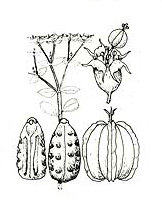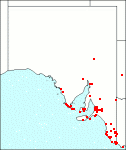Family: Euphorbiaceae
Euphorbia peplus
Citation:
L., Sp. Pl. 456 (1753).
Synonymy: Not Applicable Common name: Petty spurge, radium plant.
Description:
Erect or ascending glabrous annual to 40 cm tall, often with a main central stem and 2 or more stems from the base, green turning reddish as they mature and with usually 3 branches at the top of each stem, each branch dichotomously divided into 3-5 rays or raylets in upper axils; cauline leaves alternate, on distinct petioles to 8 mm long, suborbicular, ovate or obovate, 5-25 x 3-16 mm, obtuse, cuneate, entire; ray-leaves opposite, like the cauline but with shorter petioles; raylet-leaves smaller, slightly obliquely ovate or triangular-rhomboid, 3-15 mm long and wide, with the central vein sometimes ending in an apiculate or mucronulate tip.
Cyathia solitary and axillary on ray branches or borne at the base of the fork between raylets or terminal; involucre conical, c. 1 mm long and wide, yellowish-green, attenuated into an indistinct peduncle; glands lunate, c. 0.5 mm long, yellow, appendaged with 2 filiform whitish horns; styles erect, 2-capitate.
Capsule subglobular, c. 2 mm across, each fruitlet with 2 wavy keels on the back; seed hexagonal-ovoid, 1.1-1.4 x 0.8-1 mm, ash-white with 2 darker broad furrows on the inner face and 4 rows each of 3 or 4 dark pits on the back; caruncle cap-like, yellow, fleshy, terminal.

| Euphorbia peplus twig, cyathium, fruit and seeds.
|
Image source: fig 402d in Jessop J.P. & Toelken H.R. (Ed.) 1986. Flora of South Australia (4th edn).
|
Published illustration:
Hegi (1924) Illustrierte Flora von Mittel-Europa 5, 1:fig. 1797; Ross-Craig (1969) Drawings Brit. Pl. 26:pl. 41; Burbidge (1970) Flora of the A.C.T., fig. 240; Cunningham et al. (1982) Plants of western New South Wales, p. 457.
|
|
Distribution:
|
On a wide range of soils, usually in shaded and sheltered situations.
S.Aust.: FR, EP, MU, YP, SL, KI, SE. All States. Native to Europe, now widely naturalised all over the world as a weed of gardens or cultivation.
|
Conservation status:
naturalised
Flowering time: Aug. — Dec.
|

SA Distribution Map based
on current data relating to
specimens held in the
State Herbarium of South Australia
|
Biology:
It is acid tasting; poisonous to humans and stock. The milky sap causes dermatitis in contact with skin and eye irritation after handling the plant; the sap is used as a popular wart-treatment. (Everist (1974) Poisonous plants of Australia, p. 272).
Author:
Not yet available
|

